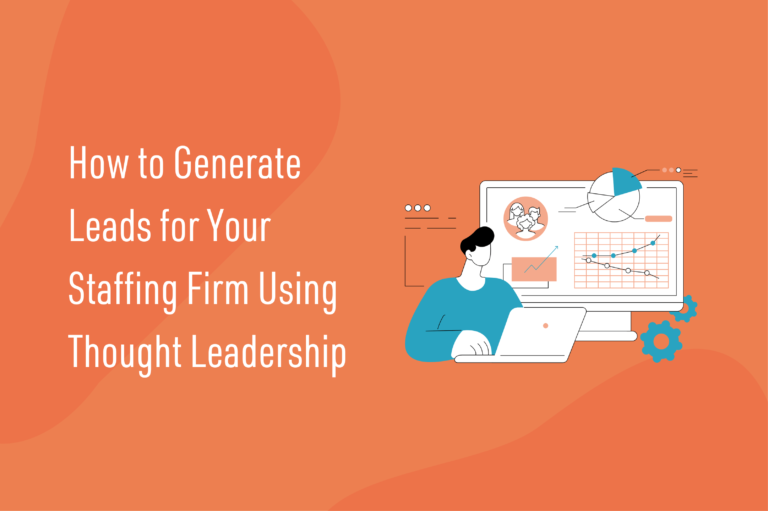In the staffing industry, a strong sales-forward culture has always been the cornerstone to generating leads and new business. However, traditional sales tactics like cold calling and cold emails are becoming less effective. This reality coupled with soft industry demand for staffing and recruiting services means that firms must adapt. As staffing firms reevaluate how to go to market and generate leads for their sales team, a thought leadership program emerges as an essential strategy.
In today’s landscape, sharing your thoughts and insights captures attention. It’s not just influencers who can benefit; leading professionals in staffing use thought leadership to drive brand awareness, recognition, and ultimately lead gen. According to the 2024 Edelman-LinkedIn B2B Thought Leadership Impact Report, 75% of enterprise decision-makers report that thought leadership has prompted them to explore services and solutions they hadn’t previously considered.
Not sure where to start or refine your current efforts? Here’s a four-step plan to effectively harness thought leadership and attract higher-quality leads:
1. Commit to a Thought Leadership Strategy
Start by integrating thought leadership into your overall marketing strategy. Consider how it can enhance your credibility and authority in the industry.
This isn’t just a side project—it should be a core component to your sales and marketing efforts. Begin by defining what thought leadership means for your staffing brand and how it aligns with your business goals. Document these goals, define your audience, commit to activity levels, and brainstorm topics. Now craft a calendar to organize your content effectively, ensuring consistency and regularity in your thought leadership efforts.
Share your strategy with your sales leaders and top producers, ensure alignment and buy-in to the gameplan. Sellers and recruiters are on the front lines, interacting with candidates, prospects and clients daily, and their support can amplify the reach and impact of your thought leadership content. Alignment between sales and marketing teams is a crucial aspect to executing your thought leadership strategy.
2. Create Compelling Content
This is the hard, but achievable part. Your lead gen content can take various forms—blogs, social media posts, ads, videos, podcasts, or infographics. Choose the format that suits you best. Perhaps you want to capitalize on the growing popularity of video by recording snippets to share with your audience, or maybe writing is your strength, and you can craft insightful blog posts (and if not, we are here to help).
To be an effective thought leader, you need to address the pain points and challenges of your audience. Draw on your experiences to create relatable and valuable content. For example, if your audience struggles with hiring because their compensation plans are misaligned to the market conditions, leverage your first party insights into salary trends and benefits. Share valuable information about niche talent markets to provide staffing buyers with unique insights. Turn this data into a salary guide and market it to your target audience.
To help generate content topics and ideas, involve the sales team in the content creation process by soliciting their insights and feedback, ensuring that the content you produce aligns with the questions and concerns they hear from clients. This collaboration will not only enhance the relevance of your content but also ensure that your sales team feels invested in its success.
3. Share Your Content on Multiple Channels
This step involves the “How” part to generate leads as a staffing and recruiting firm. Once your content is ready, it’s essential to share it across various digital channels to maximize its reach and lead gen potential.
Here’s a list of channels we at echogravity like to utilize to effectively reach target audiences:
- Internal Promotion: This is one of the simplest yet often overlooked methods to expand your reach. Sellers and recruiters in the staffing industry typically have extensive, engaged networks. By encouraging your teammates to share and engage with your content, you can significantly amplify your reach and impact.
- SEO: Optimize your content with relevant keywords to improve its discoverability on search engines. For example, if your content focuses on “hiring challenges in the biotech industry,” ensure these keywords appear naturally throughout the article, in headings, and meta descriptions.
- Email Marketing: Have you thought about implementing an ABM (Account-Based Marketing) strategy or utilizing drip campaigns to engage your target prospects? At a minimum, if you publish a new blog post about the latest hiring practices, feature it prominently in your next newsletter with a compelling headline and a brief summary.
- Social Media: In our industry, LinkedIn is where most staffing and recruiting buyers “hang out.” Multiple opportunities exist on LinkedIn, depending on the length and depth of your content, to create all kinds of posts – carousels, videos, infographics, long-form content posts, etc.
- Industry Associations: Participate in webinars, roundtables, and events to share your expertise. Are you a member of an industry trade group? Network and volunteer to host a webinar about emerging trends in talent acquisition.
- Paid Advertising: You can use Google Ads and LinkedIn Ads to target specific keywords and audiences. For example, create a LinkedIn ad campaign promoting your latest eBook on “Effective Recruitment Strategies in ABC Industry,” targeting hiring managers and decision makers.
- Influencer Partnerships: Collaborate with industry influencers to expand your reach. For instance, partner with a well-known HR influencer to co-author a blog post or appear as a guest on their podcast, discussing innovative staffing solutions.
- Podcasting: Host an industry podcast to discuss topics your target audience will find interesting. To start your own podcast series, you could tap your network to interview peers and experts in your industry.
- Content Syndication: Republish your content on third-party sites to reach a wider audience. For example, if you write an article on workforce diversity, submit it to industry publications and online platforms that accept guest contributions.
- Video Marketing: Create a short video summarizing your take on a recent industry report or your latest client survey findings and post it on YouTube, and then embed it on your website or share it to LinkedIn.
- Webinars and Live Streams: Invite your target prospects and clients to events such as roundtables and webinars. For example, you could conduct a live webinar on “How to Win the War for Talent” or “The Future of Hybrid Work” where you present your insights and answer questions from attendees.
Design your content to guide your audience through the various channels and down the marketing funnel, from awareness to decision-making. Include clear calls to action (CTAs) in your blogs and landing pages to capture information. For example, at the end of a blog post, include a CTA inviting readers to download a related whitepaper or sign up for a webinar.
Ensure your sales team is prepared to follow up promptly and effectively. Provide them with the necessary materials, such as email templates, presentations, and key messaging points, to engage leads generated through your thought leadership content. For instance, if a prospect downloads your salary guide, your sales team should follow up with a personalized email offering additional resources or propose a discovery call to further assist.
4. Measure Your Thought Leadership Efforts
Regularly evaluate the effectiveness of your content using various metrics:
- Web Analytics: Track site traffic, page views, and time spent on pages.
- Email Metrics: Monitor open rates, click-through rates, and conversion rates.
- Social Media Analytics: Measure follower growth, engagement rates, shares, and comments.
- Lead Generation Metrics: Assess the number of leads generated, conversion rates, and lead quality.
- Content Performance: Analyze downloads, views, and shares of individual content pieces.
- SEO Metrics: Track keyword rankings, organic search traffic, and backlinks.
- Sales Metrics: Evaluate the impact of content on sales activities and closed deals.
- Anecdotal Feedback: Gather feedback from informal interactions and peer comments to your content.
Tracking results, whether through software or human analysis, is crucial for identifying successes and areas for improvement. Don’t focus solely on converted leads; it’s equally important to analyze what isn’t working so you can refine your approach.
Consider thought leadership as a powerful way for your staffing firm to generate high-quality leads. As traditional sales tactics lose their edge, adapting through thought leadership becomes essential. Commit to a strong strategy, create engaging content, share it widely, and measure your success. By staying authentic and leveraging your expertise, you can connect with your audience, solve their challenges, and drive business growth.












